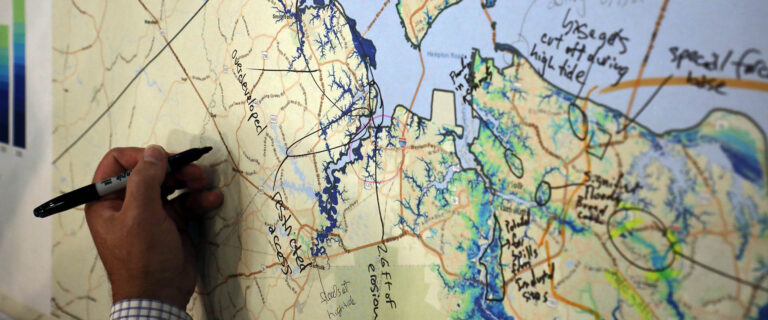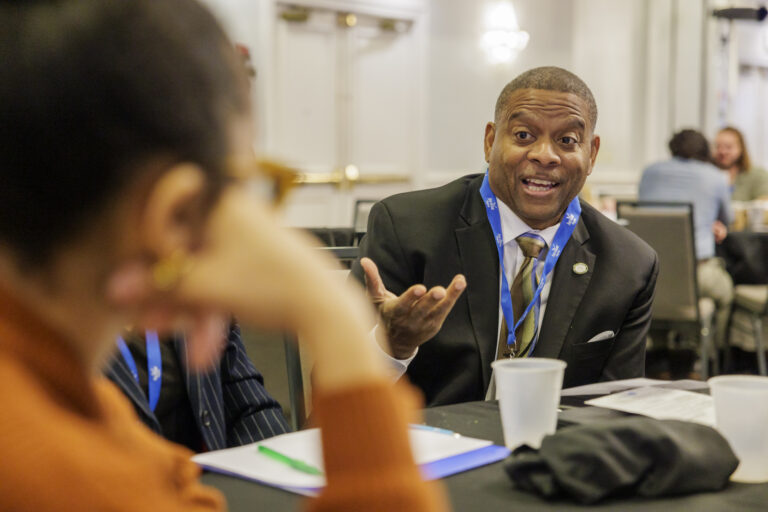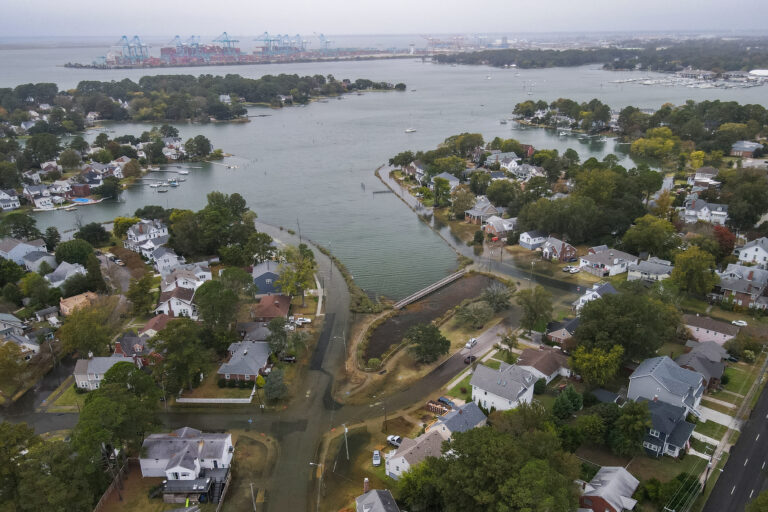Working group channels regional whelk knowledge
Channeled whelk can be found from Massachusetts all the way to Florida, but Virginia supports one of the largest channeled whelk fishing industries of the East Coast. In Virginia, they are typically caught in pots along the Eastern Shore of Virginia and off the coast of Virginia Beach. But since channeled whelk are slow to mature, overfishing can create boom-and-bust cycles of fishing that make it difficult for whelk populations to rebound.
Although every coastal state from Massachusetts to North Carolina has a commercial industry that harvests channeled whelk, no two states monitor whelk fishing the same way. To support regional collaboration among Atlantic states, Bob Fisher, a Virginia Institute of Marine Science fisheries specialist and Virginia Sea Grant extension agent, organized a regional working group.
The meetings brought together researchers, resource managers, and commercial fishers to discuss management strategies for channeled whelk. The group met weekly in January and February 2021 to identify future research priorities, discuss findings from recent research, and discuss current management strategies.
Among the presenters was Fisheries Technician Sam Askin, who researched the genetic differences of channeled whelk along the East Coast as a VIMS master’s student. After studying samples from Massachusetts to South Carolina, she found that most whelk populations were genetically distinct from one another. In Virginia, distinct channeled whelk populations in Virginia Beach and along the Eastern shore mean that if a population is overfished, whelk from another area won’t be able to travel far enough to replace them.
The working group allowed her to share updates from her research, and also allowed states who share borders to collaborate about more uniform regulations. The Atlantic states marine Fisheries Commission also provided insight about how states could move toward regional management.
“Even though channeled whelk have different populations, the issues within those different resources among states are very much the same,” Askin said.
Some states, like New York, have changed the minimum landing size in order to ensure enough whelk survive long enough to reproduce in the last decade. Massachusetts has also scheduled a gradual increase in the minimum size for the state’s channeled whelk landings. Virginia also made a small adjustment to its minimum landing size to allow more whelk to grow to maturity and reproduce.
Still, some states don’t require any harvest reporting or have not completed biological research needed learn about that state’s channeled whelk population. Askins said work group participants generally agreed that mandatory reporting would help managers understand whelk landings.
“We want to protect this highly valuable fishery,” Askin said. “This is a partnership, and we want to work with industry. The information they’ve gathered through working this fishery for years is important to us, and moving forward, we strive to better understand their perspective and their stake in all this.”
Additional information about channeled whelk genetics in the Northeast could help managers collaborate on management. If two states share a single population, then working together to set catch limits becomes more important, Askin explained.
“This is a partnership, and we want to work with industry. The information they’ve gathered through working this fishery for years is important to us,” Askin said.
If two states share a single population of channeled whelk, then working together to set catch limits becomes more important, Askin explained.
Although channeled whelk have been harvested recreationally for decades, Virginia’s commercial whelk fishery first took off in the 1960s, as fishers looked to whelk as the number of crabs, shrimp, and lobster dwindled. Up through the 1980s, fluxes in fishing, plus a lack of regulation, created boom and bust cycles in the 1990s-2010s that pointed to the need for additional regulation.
When Rick Robins first started in the whelk business in Virginia in the early 90s, whelk were about 60 cents a pound. By 2014, that price had increased to $2.65 a pound. In some parts of New England, the price per pound of whelk surpassed the price of American lobster in 2019. But even as prices have risen and channeled whelk have become a valuable fishery, many states have reported declining catch rates.
The working group and whitepaper follow up on an initial whelk meeting held in 2014 at the 16th International Conference on Shellfish Restoration, where many of the working group participants first discussed the biological research needed in order to develop management strategies.
After the 2021 working group, Fisher and Askin developed a whitepaper that summarized the state of the channeled whelk fishery across the Eastern Seaboard. Going forward, Askin said managers must consider the needs of the fishing industry as they take steps toward more sustainable fishing.
“In Virginia, if we were to jump our minimum landing size up, that resource isn’t there,” Askin said. “It sounds as easy as changing minimum landing size or some other management regulation, but it’s not that simple. I think that’s where additional conversations need to be had. As far as making any more concrete decisions, we really need to fill those data gaps in first.”
Takeaways:
- A series of meetings brought together channeled whelk researchers, resource managers, and commercial fishers to discuss management strategies for channeled whelk.
- Although every coastal state from Massachusetts to North Carolina has a commercial industry that harvests whelk, no two states monitor fishing the same way.
- In Virginia, distinct populations in Virginia Beach and along the Eastern shore mean that if a population is overfished, channeled whelk from another area won’t be able to travel far enough to replace them.
Middle Photo by Maryland Fisheries Service
Photos and video by Aileen Devlin | Virginia Sea Grant
Story by Madeleine Jepsen | Virginia Sea Grant
Published March 8, 2022.
“Even though channeled whelk have different populations, the issues within those different resources among states are very much the same,” Askin said.





